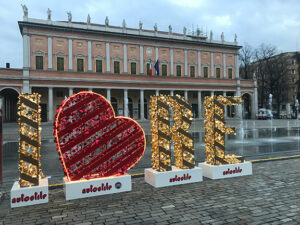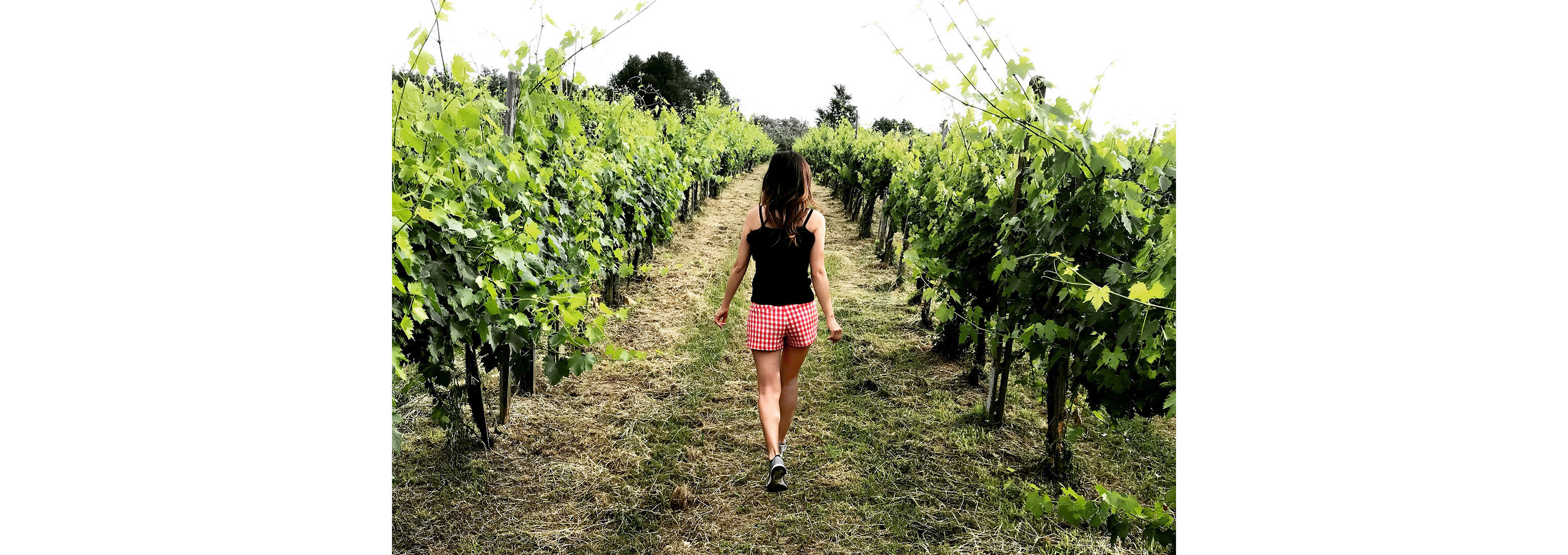The tri-colored Italian flag was established here. It’s the birthplace of a renowned educational philosophy, and the city where the young Kobe Bryant started dribbling the basketball. Reggio, as locals call it, is also the home of Luciano Pavarotti’s first operatic performance and the headquarters of Italy’s Max Mara fashion house. Amid its cobbled streets dotted with historical churches, theatres, galleries, and monuments, Reggio Emilia is already culturally and fashionably rich. And then there’s food and wine. Situated perfectly between Modena and Parma, Reggio Emilia is an oft-overlooked hub along the Emilia Romagna region’s gastronomic route, Via Emilia, in Northern Italy. But it gained one more devoted fan. Me.
In fact, the entire region is all about culinary dreams realized. Ask any Italian where they’d go to eat and drink. Besides choosing their mother’s kitchen, they’d probably tag Emilia Romagna. And, can you blame them? Tortellini was born here, after all. According to legend, it was modeled after Venus’ navel. Then there’s the tagliatelle pasta – created by a court chef who was inspired by Princess Lucrezia Borgia’s hair on the day of her wedding to the Duke of (nearby) Ferrara. But the area has more to offer than pasta shapes. How about Parmigiano Reggiano, Prosciutto di Parma (which deserves its own story later), balsamic vinegar, and Lambrusco wines? Yes, Lambrusco. All E-R material.
And my visit to the country’s agricultural heartland was the best way to experience all its gastronomic greatness.
Parmigiano Reggiano – “King of Cheeses”
Producing products of quality and authenticity takes passion and dedication. For the Parmigiano Reggiano cheesemaker, the morning starts with fresh milk – about 300 gallons (1,100 liters) – in a bell-shaped copper vat. Situated in Parma, the factory (Caseificio Ugolotti) on this day has eight cauldrons animatedly spinning milk at the same time. The morning’s and previous night’s milk, along with the addition of a culture-rich whey starter and applied heat, results in heavy, compact cheese granules which sink to the bottom of the vat. Using a strong, mesh-like cloth, two cheesemakers hoist the mass of granules – each destined to become an 80-pound Parmigiano Reggiano wheel – to the surface and tie them to a wooden rod spanning the vat. Each cloth-coddled cheese is then placed into a durable mold to give it its final shape. Overnight, a rigid plastic marking band imprints its authenticity, production date, cheese factory registration number, and the unmistakable dotted Parmigiano Reggiano markings. This serves as an identity card which makes it possible to trace its entire production back to its origins, anytime and anywhere. When removed from the molds, the wheels are left to float in a brine.
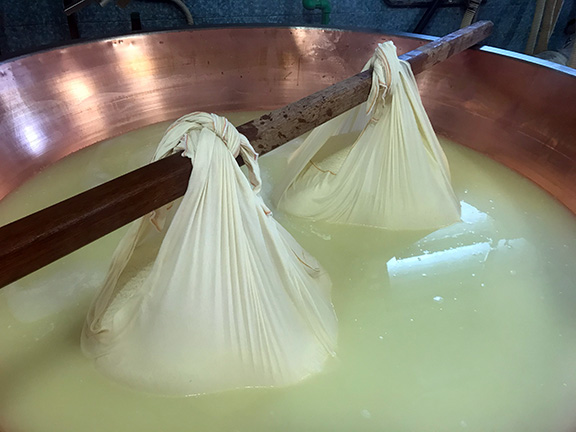
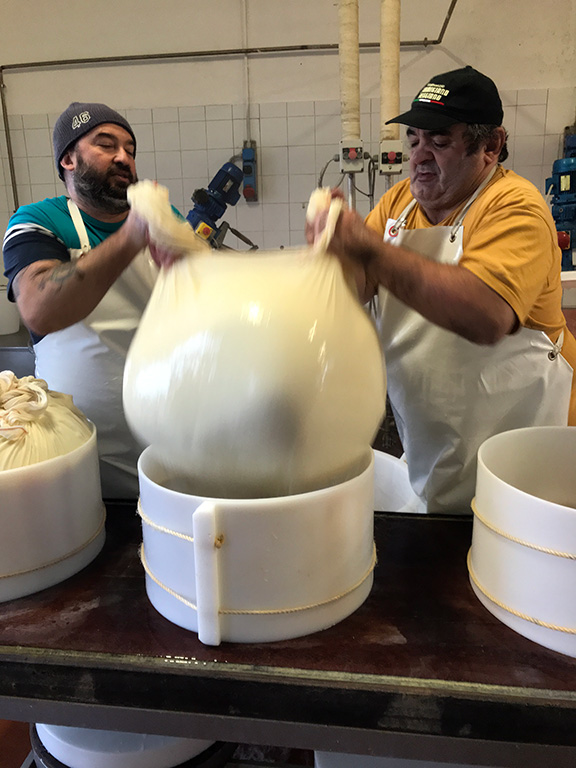
“In about three to four weeks, the salt will go into the cheese,” says Cristiana Capelli of the Parmigiano Reggiano Consortium. “Now touch – the rind is already hard. No wax, no plastic. It’s just hardened cheese on the outside. Even the label is edible.”
From a giant set of clanking keys, she finds the one that unlocks the heavy rolling doors, which open to a massive, dimly-lit room with high ceilings, under which rows of cheese wheels sit, gracefully aging. After a minimum of 12 months, the wheels are tapped like a drum by using a small hammer. This is done by a Consortium representative, like Capelli, to check for the slightest of oddities – all to ensure Parmigiano Reggiano’s tradition of integrity and excellence.
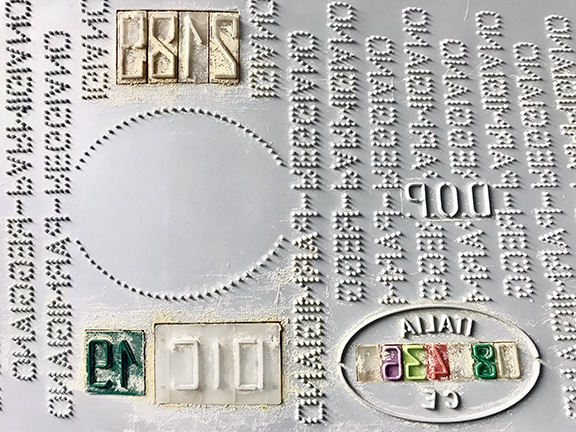
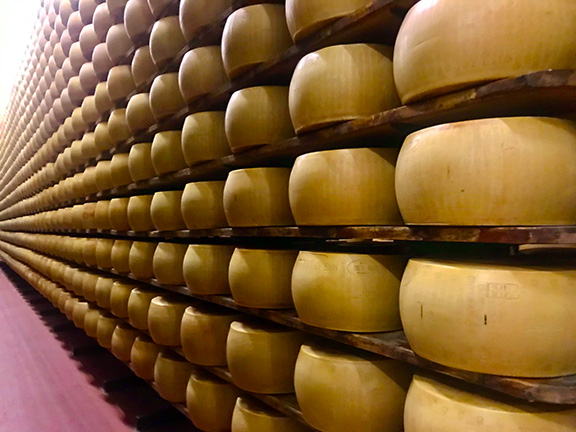
It’s important to note that for cheese to be Parmigiano Reggiano DOP, the milk production, processing, maturation, and packaging all take place exclusively in the provinces of Northern Italy, including Parma, Reggio Emilia, Modena, and parts of Bologna and Mantua. In other words, the mystery cheese labeled “Parmesan” in the dairy section of the local grocery store is not Parmigiano Reggiano.
These are not authenticated, nor made in its original birthplace. Much like Champagne or Prosciutto di Parma, Parmigiano Reggiano is legally a protected designation of origin (PDO), Denominazione di Origine Protetta (DOP) in Italian.
Parmigiano Reggiano is an extraordinary cheese, with aromas and flavors that render it unique and inimitable. Its distinct aroma is reminiscent of fresh grass from the gentle hills nearby. This hard, but not compact, cheese easily surrenders to the spade knife and crumbles into shards to reveal salty nuttiness, with the mildest degree of creaminess and pliability, especially when young, with a slight yet discernible and satisfying crystalline grit.
Lambrusco – the loveable fizzy red
What goes with something so exquisitely assertive as Parmigiano Reggiano is a wine that enhances the flavors and subtly tames its noble greatness. Around here, Lambrusco reigns in the wine category. Not only do the grapes grow within close proximity to the cows that produce the milk for the cheese, but Lambrusco has characteristics that make it famously food-friendly and delicious.
I was met by none other than Ermes Scardova, export manager of Medici Ermete, a pioneering Lambrusco producer since the late 19th century. Scardova is a man of slight stature, an avid runner, native Reggio Emilia(n), history buff, and food and wine devotee. Anyone would want to be his sidekick, if only to eat and drink well and have great conversation. He, of all people, knows the history of Lambrusco, the fresh, fizzy red of the region and how artisanal Lambruscos have been increasingly winning over the libatiously adventurous.
But, much like ambrosia salad, the canine pit bull, or Spam, Lambrusco has had a lingering image problem, in this case the relentless status as something reminiscent of grandma’s candied wine cooler. While Lambrusco is growing in popularity, it might still remain a bit misunderstood.
Chef and television host Lidia Bastianich says it well: “Lambruscos have been misrepresented by industrial versions that have the soda pop flavors they think Americans might want.” Finding a quality Lambrusco takes some resourcefulness and great ambassadors. Luckily, Lambrusco has a torch bearer, the Medici family of Medici Ermete.
“Medici Ermete was the first winery to believe in the potential of the Lambrusco grape and to enhance it,” says Scardova. “In fact, they believed in the production of single cru wines – the Lambrusco “Arte e Concerto” was the first single vineyard of Lambrusco to be produced.”

Being the first to lower production yields per hectare and practice green harvesting to obtain better quality wines was a pioneering move. They also claim to be the first winery to export Lambrusco in its original, dry form to many markets across the world.
Lambrusco’s sprightly charm is in its psychedelic violet foam, fresh effervescence and firm acidity, kept honest with the savoriness of tilled earth and a tongue-hugging dry sensation. The super power of Lambrusco is its ability to pair with a number of foods, especially rich and oily foods, such as locally-prized salumi, namely Prosciutto di Parma and mortadella served with fried pillows of gnocco fritto, pizzas, pastas, and homespun Parmigiano Reggiano.

Over dinner at Caffè Arti e Mestieri in Reggio Emilia, a contemporary take on local specialties, Scardova and I talk about the uniqueness of Lambrusco, as they are a family of grapes and wines from the Emilia side of the Emilia-Romagna region. “Lambrusco is emblematic of the distinctive offerings that can be found in Italy: wines rich in regional tradition and history, made from native grape varieties, and offering idiosyncratic style and character,” he says. “Alberto Medici (proprietor) said, ‘Lambrusco can be a universe of different varieties.’”
While no Lambrusco is alike, one of Italy’s oldest family of grape varieties give distinct wines which make them versatile for many types of cuisines, including Indian, Korean, Thai, and Vietnamese. Have it with a cheeseburger, supreme combination pizza, or salami sandwich. Pick your favorite food and pour a glass of Lambrusco di Sorbara, the lightest of the three main styles. You got a match!
“You can have an aperitif with a Lambrusco di Sorbara combined with cold cuts and cheeses, then continue with Lambrusco Salamino with tagliatelle alla Bolognese and then finish with a sweet Lambrusco Grasparossa together with a fruit salad or a tart with berries,” Scardova says.
On the table is yet another example of Lambrusco’s diversity, the metodo classico “Unique” Rosé Brut Lambrusco, made of Lambrusco Marani grapes. Together with gnocco fritto served with delicate slices of Prosciutto di Parma and mortadella, and erbazzone, a savory pie of herbs and leafy green, it is a crisp and radiating dry, fruity bubbly.
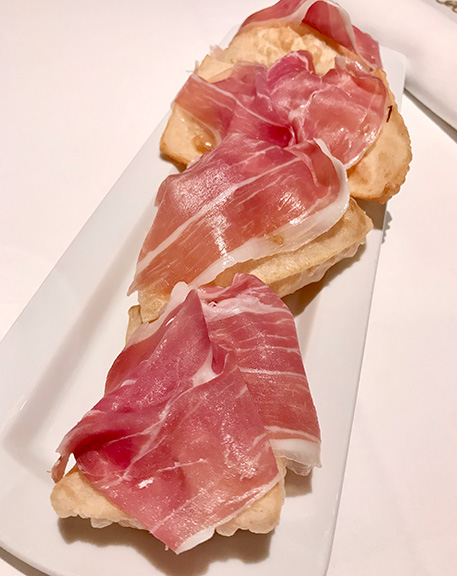
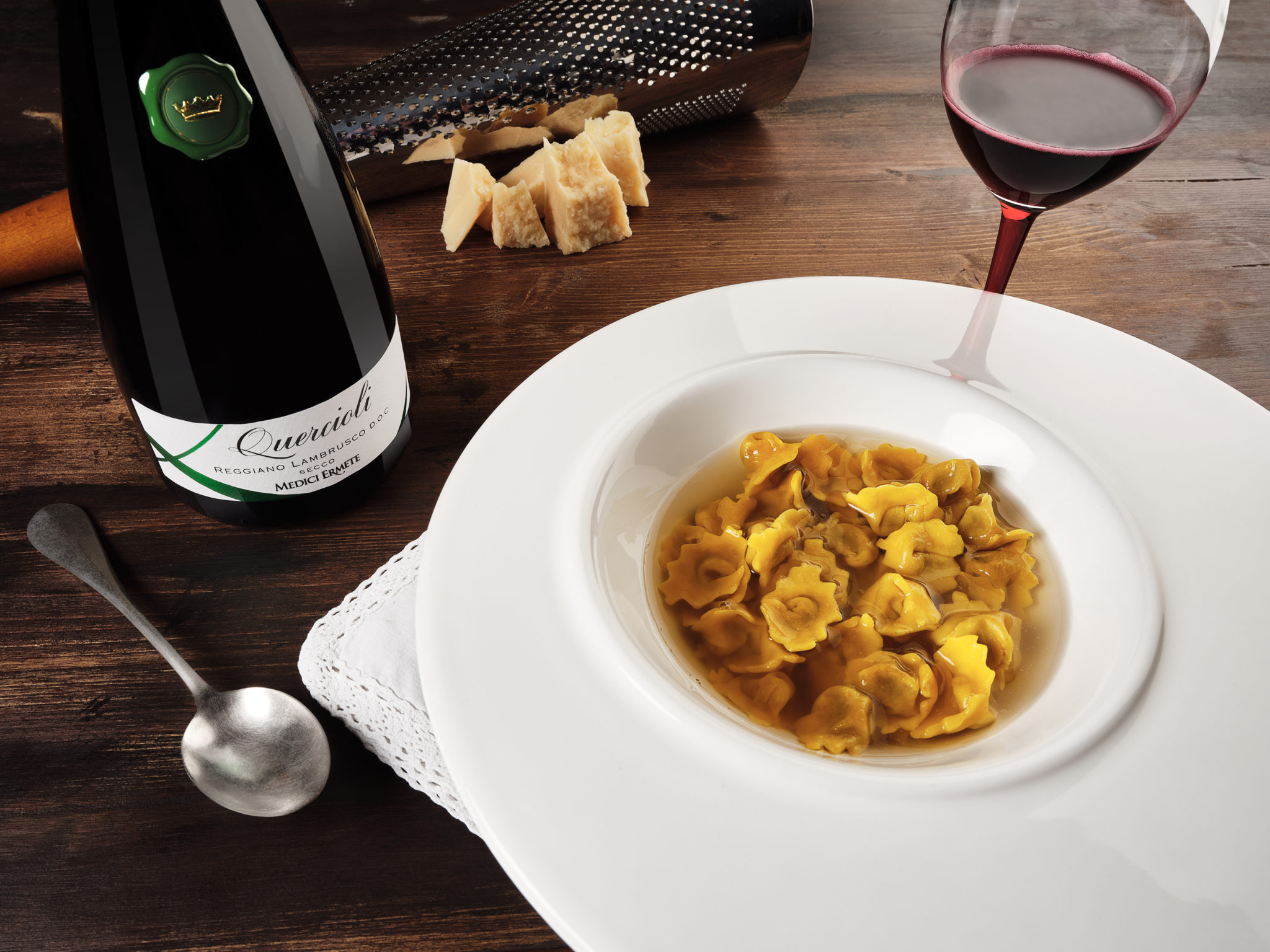
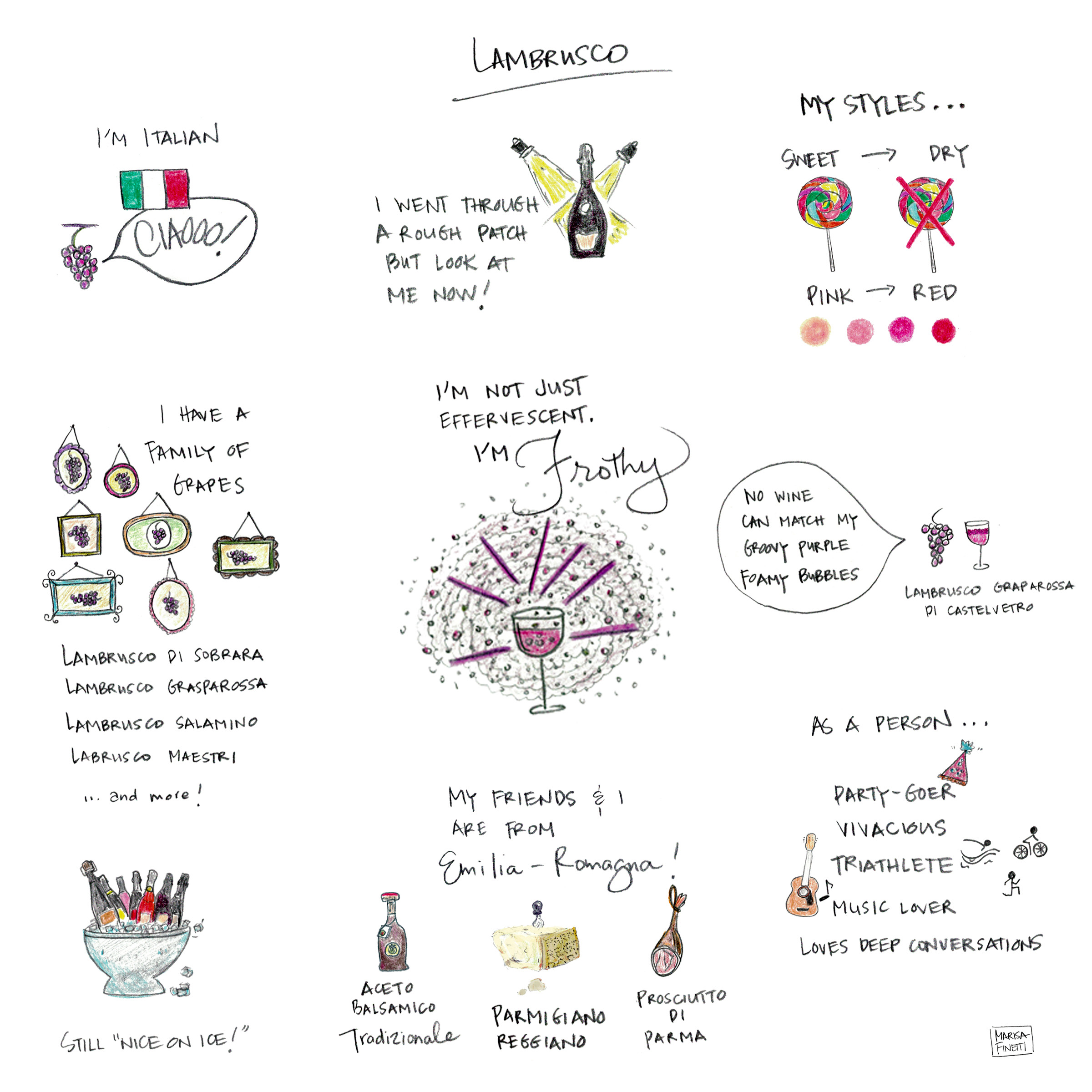
Medici’s single vineyard “Concerto” Lambrusco Reggiano DOP, made with Lambrusco Salamino grapes, accompanies the heartier part of the meal, showcasing a brilliant cube of five different layers of meat topped with a Lambrusco mousse, and cappelletti in brodo (in broth), dainty “little hats” of filled pasta akin to tortellini in a clear, hot broth. The intensely brilliant wine of dry, fruity exuberance is delectably harmonious with the cuisine. It’s vivaciously fresh with a clean finish, always preparing the palate for what’s next. Perhaps a Lambrusco cocktail to keep the night going at Jigger Spiriti e Cucina in the heart of historical Reggio Emilia? Of course! Lambrusco in cocktails is widely popular here. And understandably so. The deep, fruity, and savory frizzante offers quaffable energy in an already convivial and lively bar.

Traditional Balsamic Vinegar – handcrafted and “sealed” with love
There are many Lambrusco grapes, and part of their diversity is perhaps that they (along with other local varieties) are also used in the highly coveted balsamic vinegar, wine’s other “self.”
But not just any vinegar, where the process is quick and the result is a sharp, thin liquid. Traditional balsamic vinegar, on the contrary, is a product of passion and patience, as evidenced by its thick and luscious texture and deep flavors.
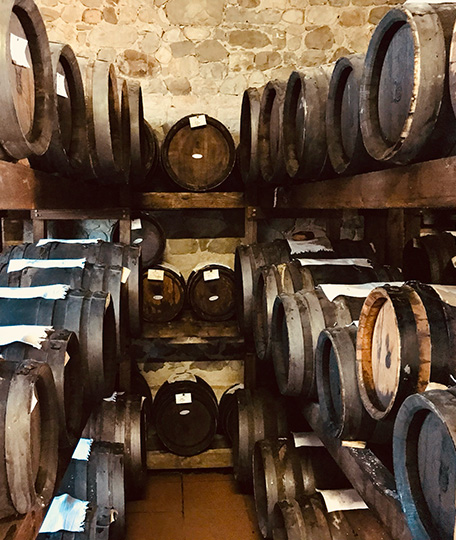
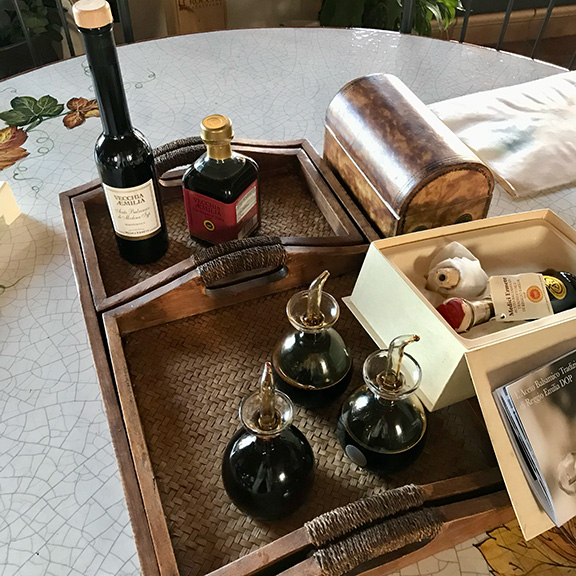
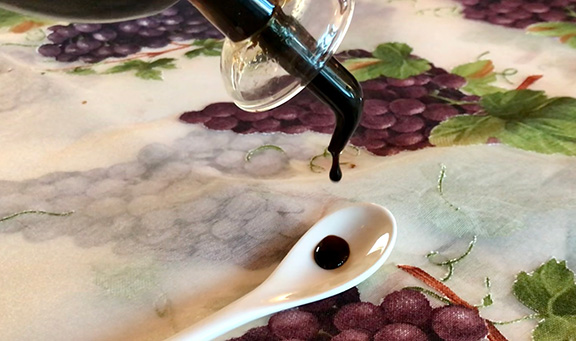
“Remember the word ‘traditional’,” says Scardova, as we ascend into Medici’s balsamic vinegar lofts at Tenuta La Rampata estate, a building that dates back to the 19th century, which are filled wall-to-wall, floor-to-ceiling with little barrels. “Aceto Balsamico Tradizionale… the most famous is from Modena, but the oldest is Reggio Emilia.”
Juice (not wine) from local grapes, such as Lambrusco and Trebbiano, are concentrated over a low flame for approximately 15 hours then aged slowly for two years in a barrique, after which time the vinegar spends a number of years in a battery of barrels (batteria) comprised of graduated sizes and consisting of two types of wood.
“At least two different woods are disciplinary of balsamic vinegar…chestnut, oak, mulberry, cherry, apricot , juniper,…” says Scardova. Every year the vinegar continues to age via the solera system, for the minimum required 12 years, the vinegar becomes thicker and more concentrated. Only then, will it undergo a strict examination by a commission of expert tasters, and if it meets specific quality and characteristics, will it bear the seal of authenticity. Clearly, making traditional balsamic vinegar is a way of life. It’s a product of nature and a product of culture.
Look for the word tradizionale, which is missing from the label of mass-produced vinegars. It’s a small distinction but indicates a big difference. The words Aceto Balsamico Tradizionale di Modena DOP or Aceto Balsamico di Reggio Emilia DOP will assure you it’s the real thing. They fetch higher prices, but promise an experience that transcends description.
How do you enjoy such exquisiteness? One drop at a time. Extra points if drizzled on Parmigiano Reggiano with a glass of Lambrusco. But from which Lambrusco grape? Ah, stay tuned for more on Lambrusco.
